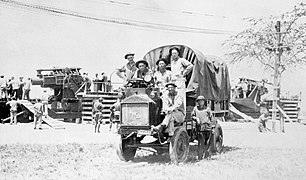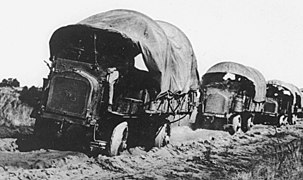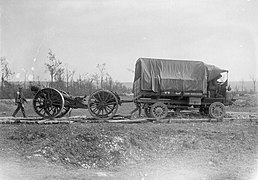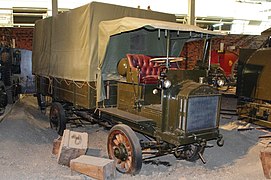
A four-wheel drive, also called 4×4 or 4WD, is a two-axled vehicle drivetrain capable of providing torque to all of its wheels simultaneously. It may be full-time or on-demand, and is typically linked via a transfer case providing an additional output drive shaft and, in many instances, additional gear ranges.

A limited-slip differential (LSD) is a type of differential gear train that allows its two output shafts to rotate at different speeds but limits the maximum difference between the two shafts. Limited-slip differentials are often known by the generic trademark Positraction, a brand name owned by General Motors and originally used for its Chevrolet branded vehicles.

In automotive design, a front-engine, front-wheel-drive (FWD) layout, or FF layout, places both the internal combustion engine and driven roadwheels at the front of the vehicle.

A half-track is a civilian or military vehicle with regular wheels at the front for steering and continuous tracks at the back to propel the vehicle and carry most of the load. The purpose of this combination is to produce a vehicle with the cross-country capabilities of a tank and the handling of a wheeled vehicle.

The Four Wheel Drive Auto Company, more often known as Four Wheel Drive (FWD), was a pioneering American company that developed and produced all-wheel drive vehicles. It was founded in 1909 in Clintonville, Wisconsin, as the Badger Four-Wheel Drive Auto Company by Otto Zachow and William Besserdich. The first production facility was built in 1911 and was designed by architect Wallace W. DeLong of Appleton, Wisconsin.

A drive wheel is a wheel of a motor vehicle that transmits force, transforming torque into tractive force from the tires to the road, causing the vehicle to move. The powertrain delivers enough torque to the wheel to overcome stationary forces, resulting in the vehicle moving forwards or backwards.

Six-wheel drive is an all-wheel drive drivetrain configuration of three axles with at least two wheels on each axle capable of being driven simultaneously by the vehicle's engine. Unlike four-wheel drive drivetrains, the configuration is largely confined to heavy-duty off-road and military vehicles, such as all-terrain vehicles, armored vehicles, and prime movers.

The Premier Motor Manufacturing Company built the brass era and vintage Premier luxury automobile in Indianapolis, Indiana, from 1903 to 1925.

The Diamond T Company was an American automobile and truck manufacturer. They produced commercial and military trucks.

The AMC M422 'Mighty Mite', or G-843 by its supply catalog designation, is an extra lightweight ¼-ton 4x4 tactical truck, designed for the United States Marine Corps, to be suitable for helicopter airlift and manhandling. It is noted for its exceptionally short length, and resulting very tight turning circle, while still highway approved for a top speed of 55 mph (89 km/h), and capable of 65 mph (105 km/h) according to its manufacturer, American Motors Corporation (AMC). From 1959 through 1962, just under 4,000 M422 Mighty Mites were built by American Motors for the U.S. Marines.

An articulated hauler, articulated dump truck (ADT), or sometimes a dump hauler, is a very large heavy-duty type of dump truck used to transport loads over rough terrain, and occasionally on public roads. The vehicle usually has all-wheel drive and consists of two basic units: the front section, generally called the tractor, and the rear section that contains the dump body, called the hauler or trailer section. Steering is made by pivoting the front in relation to the back by hydraulic rams. This way, all wheels follow the same path, making it an excellent off-road vehicle.

The G-506 trucks, 1+1⁄2-ton, 4x4, produced as the Chevrolet G7100 models, were a series of (light) medium four wheel drive trucks used by the United States Army and its allies during and after World War II. This series came in standard cargo, as well as many specialist type bodies.
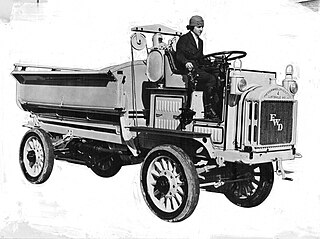
Luella Bates is believed to be the first licensed woman truck driver.

The Jeffery Quad, also known as the Nash Quad or Quad is a four-wheel drive, 11⁄2-ton rated truck that was developed and built by the Thomas B. Jeffery Company from 1913 in Kenosha, Wisconsin, and after 1916 by Nash Motors, which acquired the Jeffery Company. Production of the Quad continued unchanged through 1928.

An all-wheel drive vehicle is one with a powertrain capable of providing power to all its wheels, whether full-time or on-demand.

The 6-ton 6×6 truck was a family of heavy tactical trucks built for the United States Army during World War II. The basic cargo version was designed to transport a 6- short ton (5,400 kg) cargo load over all terrain in all weather. The chassis were built by Brockway Motor Company, The Corbitt Company, The Four Wheel Drive Auto Company (FWD), Ward LaFrance Truck Corporation, and White Motor Company. They were replaced by the M54 5-ton 6x6 trucks in the 1950s.

The 2+1⁄2-ton, 6×6 truck was a standard class of medium duty trucks, designed at the beginning of World War II for the US Armed Forces, in service for over half a century, from 1940 into the 1990s. Also frequently known as the deuce and a half, or just deuce, this nickname was popularized post WWII, most likely in the Vietnam War era. The basic cargo versions were designed to transport a cargo load of nominally 2+1⁄2 short tons over all terrain, in all weather. The 2+1⁄2-ton trucks were used ubiquitously in World War II, and continued to be the U.S. standard medium duty truck class after the war, including wide usage in the Korean and Vietnam Wars, as well as the first Gulf War.

The Militor truck, officially 3-ton truck, Ordnance Department Model 1918, was designed and built by the Militor Corporation for the United States Army Ordnance Department as a standardized four-wheel drive 3-ton truck and artillery tractor toward the end of World War I. With the end of the war, larger orders were cancelled and 75 were built, these being issued to the Artillery Corps.

